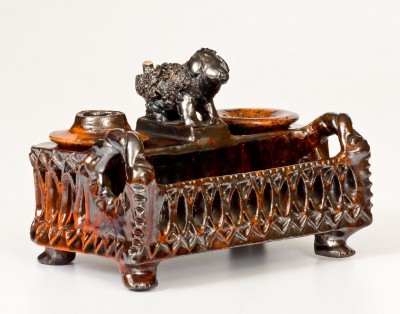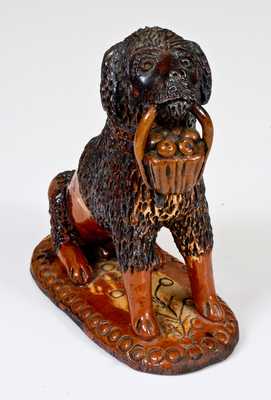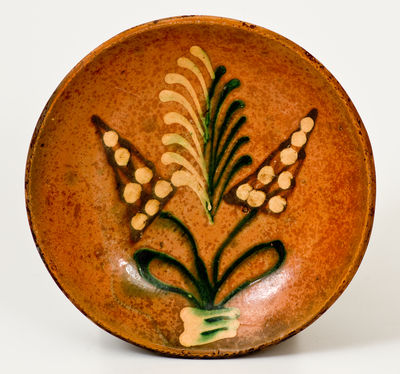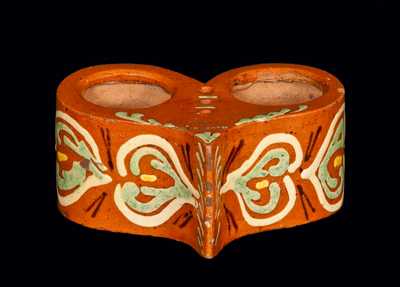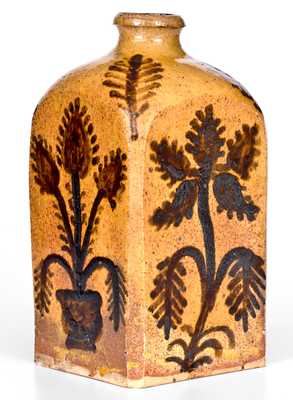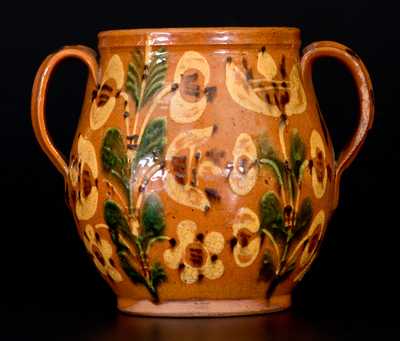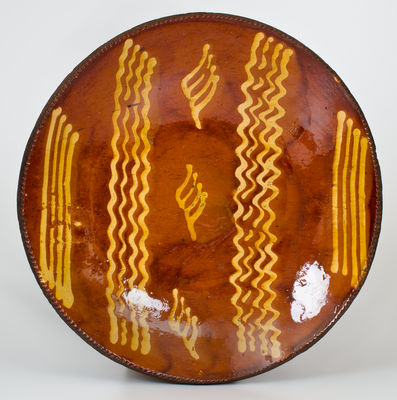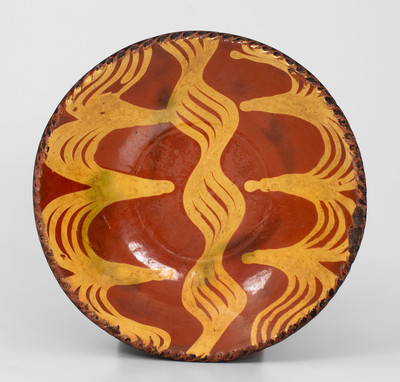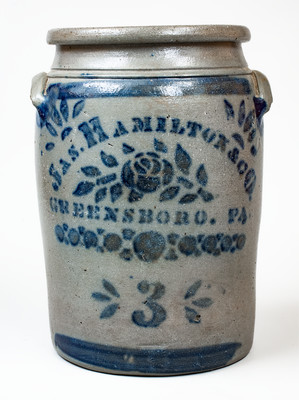Very Rare Sgraffito-Decorated Redware Plate with Exuberant Flowering Urn Motif, Dated "Mar 27 1830," attributed to John Monday, Haycock Township, Bucks County, PA, 1830, with coggled edge, the slip-coated interior sgraffito-decorated with an open-handled urn brimming with an elaborate flowering plant bearing two tulips flanking a tulip bud, two lower pinwheel-shaped blossoms, and a central four-petaled blossom interspersed with sprigs. Urn motif includes fine sgraffito decoration throughout, its shoulder featuring sawtoothed and vertical dashed designs, its belly with a large tulip design mimicking the tulips above. Inscribed with the date, "mar 27 1830" at base. Interior of plate further decorated throughout with brushed copper dashes and covered in a clear lead glaze. This work features classic Pennsylvania German design elements connecting it to Bucks County potter, John Monday, as well as Conrad Mumbauer, the man who likely taught him the potter's trade. It is set apart from the vast majority of Pennsylvania German sgraffitoware by its extraordinary condition. Provenance: Philip Cowan, Phoenixville, PA, 1968; Ralph Esmerian Collection; Visual Grace: Important American Folk Art from the Collection of Ralph O. Esmerian, Sotheby's New York, NY, January 25, 2014, lot 506. Literature: Illustrated in Hollander, American Radiance: The Ralph Esmerian Gift to the American Folk Art Museum, p. 147, discussed on p. 445 with the following passage: "John Monday, one of a close-knit group of potters working in Haycock Township during the first half of the nineteenth century, is thought to have apprenticed with Conrad Mumbouer (or Mumbower), who had established a pottery in the region by 1793. Monday married Mumbouer's daughter Phebe in 1834 and took over the full operation of Mumbouer's pottery in 1845, Because of this close relationship and the similar techniques and decorative styles shared by the two potters, their surviving works are quite similar and often hard to distinguish. Few documented, signed examples by either artist are currently known. This plate is attributed to Monday based upon the similarity of several aspects of the pattern design and execution of its sgraffito decoration to one signed example in the collection of the Philadelphia Museum of Art. Each features a thick, opaque white slip ground, which was removed in areas, such as the panels of the pinwheel devices, stylized tulips, and urn, to reveal the red clay body underneath, The carving tool consistently left 1/8-inch wide, flat, shallow blade scars in the clay which are visible through the clear lead glaze. Monday also seems to have used a thinly edged coggle wheel to score in the slightly scalloped, segmented lines forming the stems and outlines of flowers. The stems of these flower designs also incorporate a slight, hollow swell near the flower blossom. The form of tulip seen on this example, with long, thinly carved petals of two different lengths and coggled outlines enclosing a green center with an elongated, feathered stamen, is also characteristic of his sgraffito patterns. A number of other potters and apprentices worked with Monday in the pottery, including both his sons, Edmund and David, and German immigrant potters Mathias Myer and Charles Moritz. Consequently, we may never truly know the specific primary hands involved in the making of individual examples, even when they bear the signature of the master potter. –J.L.L." Exceptional condition for its type with small chips and wear to edge and a few tiny glaze flakes to interior. Diam. 10 3/4".







